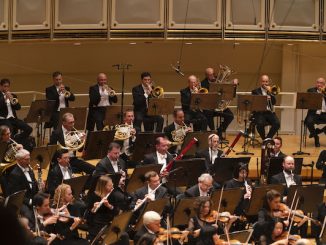
Much decorated Dutch Conductor Bernard Haitink, Patron of the Radio Philharmonic and Honorary Conductor of the Royal Concertgebouw Orchestra, returned to Symphony Center, 220 S. Michigan, on October 25th, 2018, to conduct The Chicago Symphony Orchestra (CSO) in Beethoven’s Second Piano Concerto, joined by British pianist Paul Lewis, and Bruckner’s Sixth Symphony, in a program to be repeated October 27th and 30th. For this week’s program, David Cooper, Principal Horn of the Dallas Symphony Orchestra is guest principal horn.
The distinguished Haitink, CH KBE, Gramaphone Awards Lifetime Achievement Award winner (U.K. 2015), long beloved by Chicago audiences not least because of his 2006-2010 Principal Conductorship with the Chicago Symphony Orchestra, of course includes a wide variety of repertoire in his conducting history. In particular respect to the instant engagement, there is notably extant among his many recordings the complete symphonies of Bruckner, a recent- May 2017- live recording of Bruckner’s Sixth, and several sets of the complete piano concertos of Beethoven with various pianists, all well regarded. Haitink is a master of elegant restraint, in deft and seemingly effortless control.
In 2010, Harmonia Mundi released a 3-disc set of the complete (5) Beethoven Piano Concertos performed by Paul Lewis with the BBC Symphony Orchestra under the baton of Jirí Belohlávek. By that time, beginning in 2005, Lewis had already performed the 32 Beethoven sonatas in a series of recitals in Europe and the U.S, releasing those as well through Harmonia Mundi in a 10-disc set. Both sets were well-received and it can be justly stated that Lewis has established a reputation as an exceptionally fine pianist, especially in his interpretations of Beethoven’s piano oeuvre. His performance with the Chicago Symphony Orchestra was fully potentiated, refined and engrossing.

– Ludwig Van Beethoven Piano Concerto No. 2 in B-flat Major, Op. 19, 1790-95, revised 1801
Lewis gave us a Second that was imaginative and appeared spontaneous; moderately paced. The music had plenty of strength, both in the piano and orchestral sonorities. This lucid pianist is quite restrained, and never attempted to overpower the “sonic soundscape” with large forte gestures or percussive-type sounds. As always, the Chicago Symphony Orchestra played with crisp precision and clear phrasing. Lewis himself is a master of subtlety, presenting the piece with a general lightness of feeling.
The Concerto opens with the Orchestra introducing two distinct themes, including a dramatic passage leading into the second theme; however, when the piano enters, it starts with its own new theme, before “circling back” to refer to the Orchestra’s opening. The second movement is quite lovely and deceptively simple sounding. Lyrical, almost free flowing and dramatic, it contains recitative-like piano passages toward the end, until the Orchestra enters to round out the movement.
Next, after a peaceful midsection, comes the feisty rondo of the ending, the shortest movement in the piece. Richly orchestral, filled with lighthearted melodies, it calls for a virtuoso pianist to create a celebratory sense. The two themes of the rondo are sweet and playful, segueing into a dramatic contrasting middle section and a fulsome finale.
Lewis’ style can be exemplified by his attentive handling of the finale, with its overall smoothness, energetic runs and sunny, graceful interpretation.

–Anton Bruckner Symphony No. 6 in A Major, 1879-81
Bruckner’s Sixth has been described as “the most elusive of the composer’s mature symphonies.“ It’s an unusual, iconoclastic piece of musical revelry, bold and grand in concept.
The first movement opens with a quiet, simple yet animated rhythm announced by the violins. This rhythm will continue to surface throughout the first movement, becoming its signature or heartbeat, although there are layers of rhythmic complexity in the second theme. In the development, an unusual 6-note figure forms a canonical sound, growing into an ominous presence before moving into a majestic unfolding coda.
In the very solemn second movement the symphony reaches a densely dramatic intimate core, a mysterious lament, interspersed with a soaring and uplifting sense and a then a deep, dark, restless, funereal march. The coda is hypnotic, with the prominent oboe culminating in a single and final serene statement before the fantastic Scherzo enters with an ominous sacred pulsing sound calling us to this turbulent dark dance.
The finale commences with disruptive brass elements, coalescing with the oboe’s returning lament; the Orchestra practically frolicked into the coda; at the very end, a thundering triad brings us to the closing bars, a return to the main theme of the first movement.
In the definitive, expressively controlled hands of Haitink, the symphony’s moments of introspection are not swept aside for the more dramatic phrases. The main themes are taken at a brisk pace- this Orchestra can handle any shifts of tempo or key with equanimity. With the Conductor fully aware of the various melodic and harmonic adventures, the tensions were kept well in mind- and in balance.
The Chicago Symphony Orchestra strings throughout this piece formed a lush layer of transcendent sound, carefully interwoven with piping woodwinds; the fine CSO brass sounded deep and rich, surmounted by piercing trumpets.

This was a beautifully balanced program, thoroughly realized. Haitink’s command was complete, impactful, strong and serene. At the conclusion, amid long and heartfelt applause, which included cheers, the Maestro made several well-deserved curtain calls, finally raising his arms good-humoredly as though to say, “Enough!”
For information and tickets to all the fine programs of The Chicago Symphony Orchestra, go to www.cso.org
All photos by Todd Rosenberg




Be the first to comment